How To Create Raid In Linux
In this tutorial, we'll be talking about RAID, specifically we will set up software RAID 1 on a running Linux distribution.
What is RAID?
RAID stands for Redundant Array of Inexpensive Disks. RAID allows you to turn multiple physical hard drives into a single logical hard drive. There are many RAID levels such as RAID 0, RAID 1, RAID 5, RAID 10 etc.
Here we will discuss about RAID 1 which is also known as disk mirroring. RAID 1 creates identical copies of data. If you have two hard drives in RAID 1, then data will be written to both drives. The two hard drives have the same data.
The nice part about RAID 1 is that if one of your hard drive fails, your computer or server would still be up and running because you have a complete, intact copy of the data on the other hard drive. You can pull the failed hard drive out while the computer is running, insert a new hard drive and it will automatically rebuilds the mirror.
The downside of RAID 1 is that you don't get any extra disk space. If your two hard drives are both 1TB, then the total usable volume is 1TB instead of 2TB.
Hardware RAID vs Software RAID
To set up RAID, you can either use a hard drive controller, or use a piece of software to create it. A hard drive controller is a PCIe card that you put into a computer. Then you connect your hard drives to this card. When you boot up the computer, you are going to see an option that allows you to configure the RAID. You can install an operating system on top of hardware RAID which can increase uptime.
Software RAID requires you already installed an operating system. It's good for storing data.
Basic Steps to Create Software RAID 1 on Linux
- First you need to have a Linux distribution installed on your hard drive. In this tutorial we will name it
/dev/sda. - Then you are going to grab two hard drives which will be named
/dev/sdband/dev/sdcin this post. These two hard drives can be of different sizes. Remember to back up your existing data before formating your hard drives. - Next, we will create special file systems on
/dev/sdband/dev/sdc. - And finally create the RAID 1 array using the
mdadmutility.
Step 1: Format Hard Drive
Insert two hard drives into your Linux computer, then open up a terminal window. Run the following command to check the device name.
sudo fdisk -l

You can see mine is /dev/sdb and /dev/sdc.
Then run the following 2 commands to make new MBR partition table on the two hard drives. (Note: this is going to wipe out all existing partitions and data from these two hard drives. Make sure your data is backed up.)
sudo parted /dev/sdb mklabel msdos sudo parted /dev/sdc mklabel msdos
You can create GPT partition table by replacing msdos with gpt, but for the sake of compatibility, this tutorial will create MBR partition table.
Next, use the fdisk command to create a new partition on each drive and format them as a Linux raid autodetect file system. First do this on /dev/sdb.
sudo fdisk /dev/sdb
Follow these instructions.
- Type n to create a new partition.
- Type p to select primary partition.
- Type 1 to create /dev/sdb1.
- Press Enter to choose the default first sector
- Press Enter to choose the default last sector. This partition will span across the entire drive.
- Typing p will print information about the newly created partition. By default the partition type is Linux.
- We need to change the partition type, so type t.
- Enter fd to set partition type to
Linux raid autodetect. - Type p again to check the partition type.
- Type w to apply the above changes.
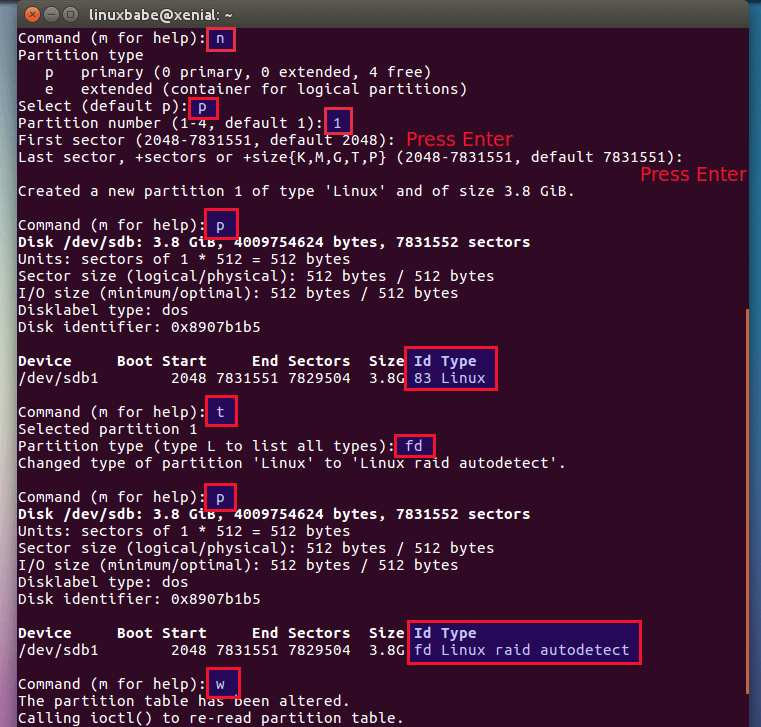
Follow the same instruction to create a Linux raid autodetect partition on /dev/sdc.
Now we have two raid devices /dev/sdb1 and /dev/sdc1.
Step 2: Install mdadm
mdadm is used for managing MD (multiple devices) devices, also known as Linux software RAID.
Debian/Ubuntu: sudo apt install mdadm CentOS/Redhat: sudo yum install mdadm SUSE: sudo zypper install mdadm Arch Linux sudo pacman -S mdadm
Let's examine the two devices.
sudo mdadm --examine /dev/sdb /dev/sdc

You can see that both are the type fd (Linux raid autodetect). At this stage, there's no RAID setup on /dev/sdb1 and /dev/sdc1 which can be inferred with this command.
sudo mdadm --examine /dev/sdb1 /dev/sdc1

Step 3: Create RAID 1 Logical Drive
Execute the following command to create RAID 1. The logical drive will be named /dev/md0.
sudo mdadm --create /dev/md0 --level=mirror --raid-devices=2 /dev/sdb1 /dev/sdc1
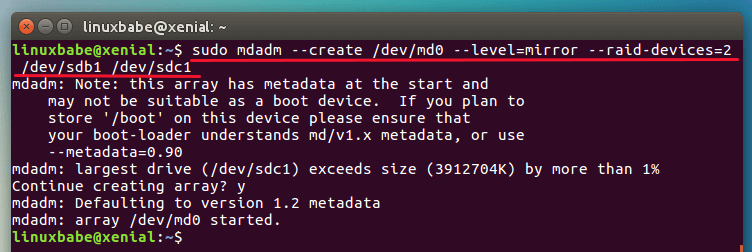
Note: If you see this message: "Device or resource busy", then you may need to reboot the OS.
Now we can check it with:
cat /proc/mdstat

You can see that md0 is active and is a RAID 1 setup. To get more detailed information about /dev/md0, we can use the below commands:
sudo mdadm --detail /dev/md0
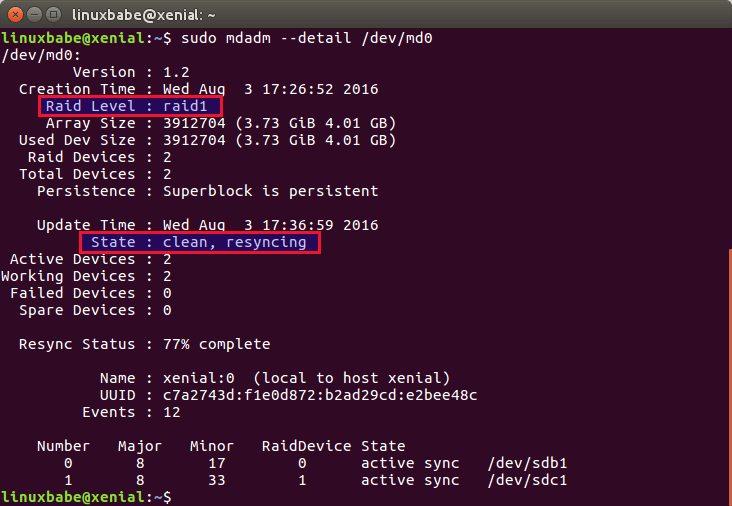
To obtain detailed information about each raid device, run this command:
sudo mdadm --examine /dev/sdb1 /dev/sdc1

Step 4: Create File System on the RAID 1 Logical Drive
Let's format it to ext4 file system.
sudo mkfs.ext4 /dev/md0
Then create a mount point /mnt/raid1 and mount the RAID 1 drive.
sudo mkdir /mnt/raid1 sudo mount /dev/md0 /mnt/raid1
You can use this command to check how much disk space you have.
df -h /mnt/raid1

Step 5: Test
Now let's go to /mnt/raid1 and create a text file.
cd /mnt/raid1 sudo nano raid1.txt
Write something like
This is raid 1 device.
Save and close the file. Next, remove one of your drive out from your computer and check the status RAID 1 device again.
sudo mdadm --examine /dev/sdb1 /dev/sdc1
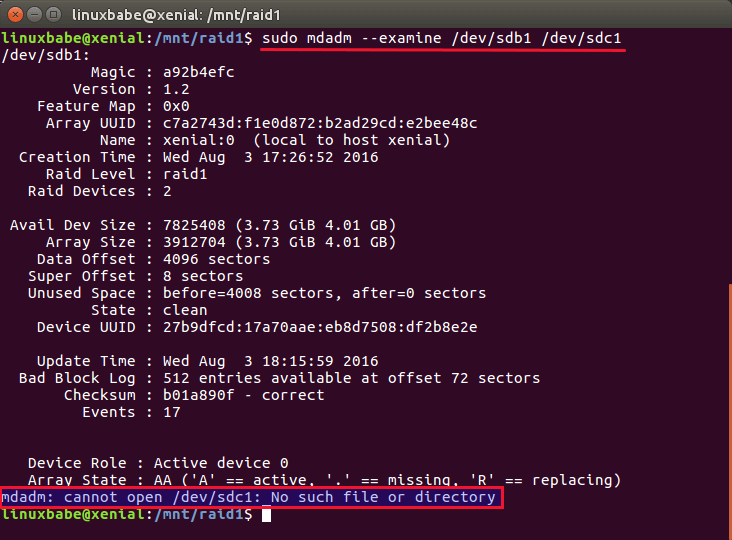
You can see that /dev/sdc1 is not available. If we check /dev/md0, we can see that one RAID device is removed.
sudo mdadm --detail /dev/md0
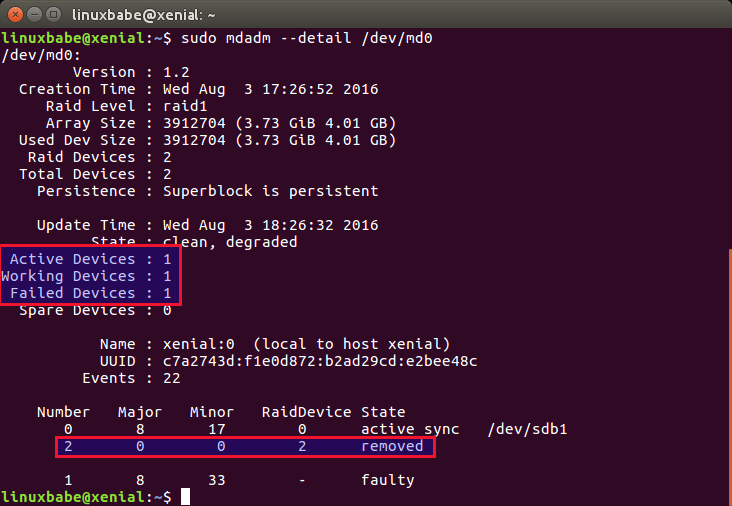
However, the text file is still there.
cat /mnt/raid1/raid1.txt

To add the failed drive (in this case /dev/sdc1) back to the RAID, run the following command.
sudo mdadm --manage /dev/md0 --add /dev/sdc1
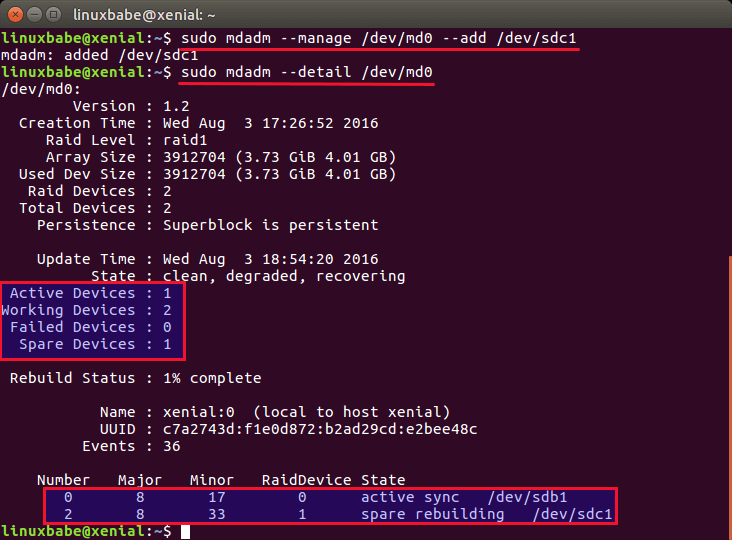
It's very important to save our RAID1 configuration with the below command.
sudo mdadm --detail --scan --verbose | sudo tee -a /etc/mdadm/mdadm.conf
Output:
ARRAY /dev/md/0 level=raid1 num-devices=2 metadata=1.2 spares=1 name=xenial:0 UUID=c7a2743d:f1e0d872:b2ad29cd:e2bee48c devices=/dev/sdb1,/dev/sdc1
On some Linux distribution such as CentOS, the config file for mdadm is /etc/mdadm.conf. You should run the following command to generate a new initramfs image after running the above command.
sudo update-initramfs -u
To automatically mount the RAID 1 logical drive on boot time, add an entry in /etc/fstab file like below.
/dev/md0 /mnt/raid1 ext4 defaults 0 0
You may want to use the x-gvfs-show option, will let you see your RAID1 in the sidebar of your file manager.
/dev/md0 /mnt/raid1 ext4 defaults,x-gvfs-show 0 0
How to Remove the RAID
If you don't want to use the RAID anymore, run the following command to remove the RAID.
sudo mdadm --remove /dev/md0
Then edit the mdadm.conf file and comment out the RAID definition.
#ARRAY /dev/md0 level=raid1 num-devices=2 metadata=1.2 spares=1 name=bionic:0 UUID=76c80bd0:6b1fe526:90807435:99030af9 # devices=/dev/sda1,/dev/sdb1
Also, edit /etc/fstab file and comment out the line that enables auto-mount of the RAID device.
Wrapping Up
I hope this tutorial helped you create software RAID 1 on Linux. As always, if you found this post useful, subscribe to our free newsletter or follow us on Google+, Twitter or like our Facebook page.
How To Create Raid In Linux
Source: https://www.linuxbabe.com/linux-server/linux-software-raid-1-setup
Posted by: smithwich1999.blogspot.com

0 Response to "How To Create Raid In Linux"
Post a Comment